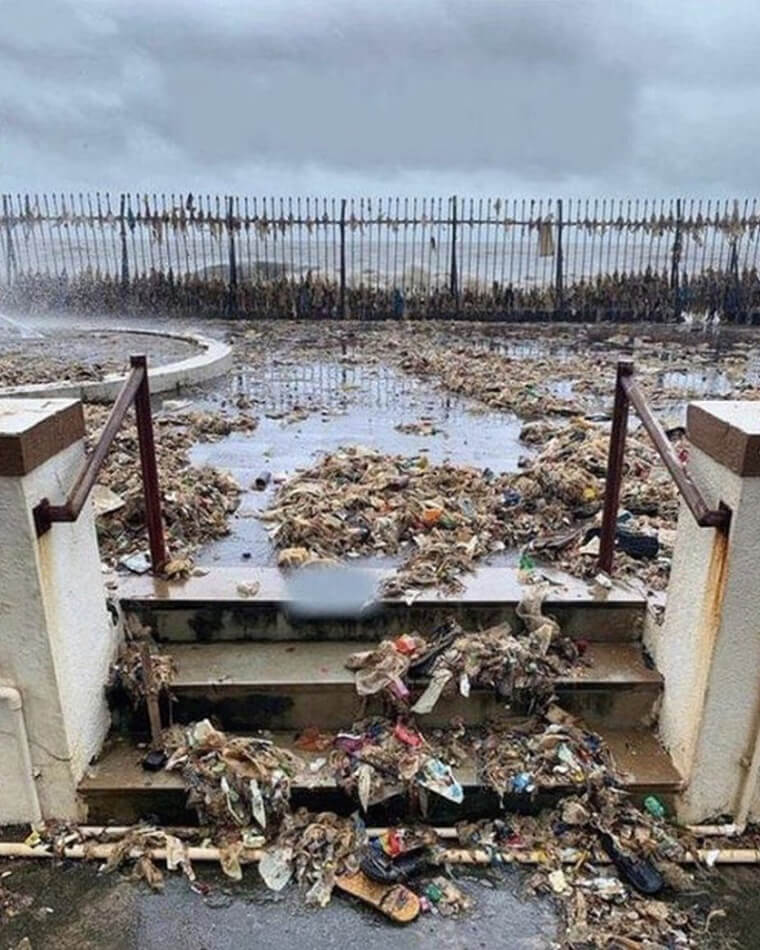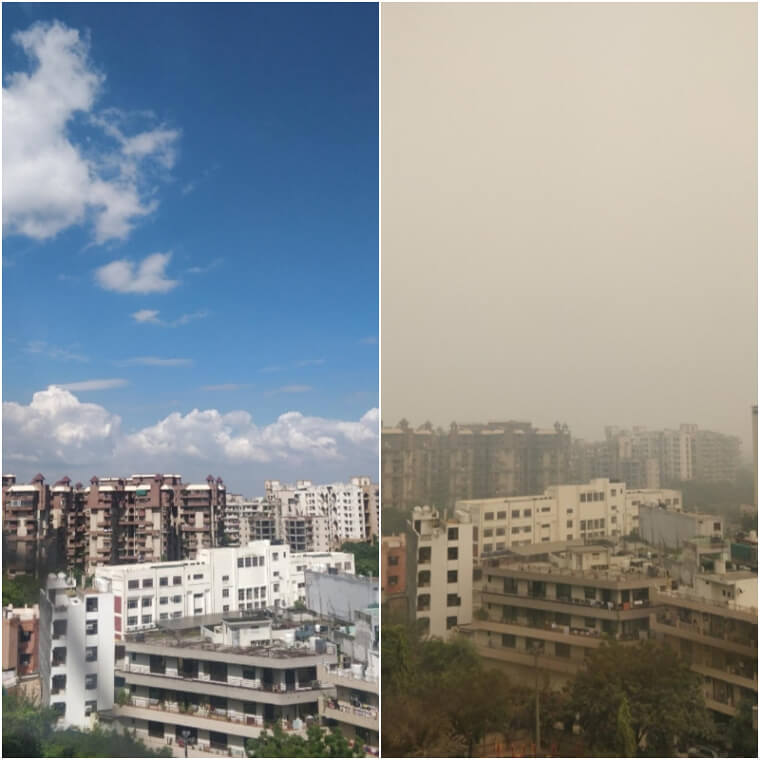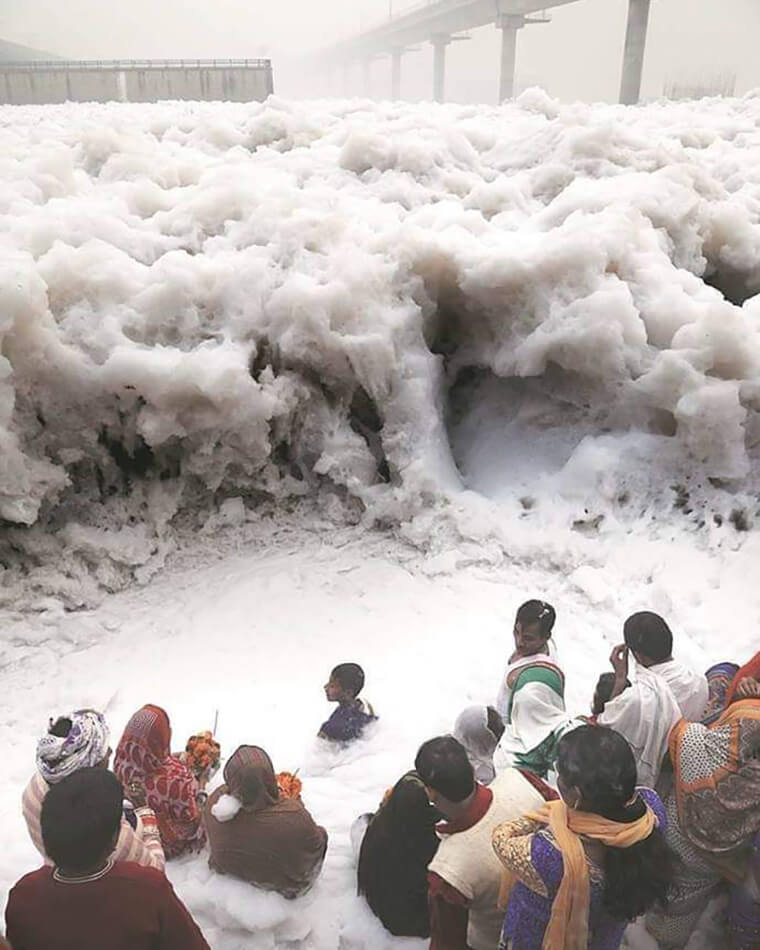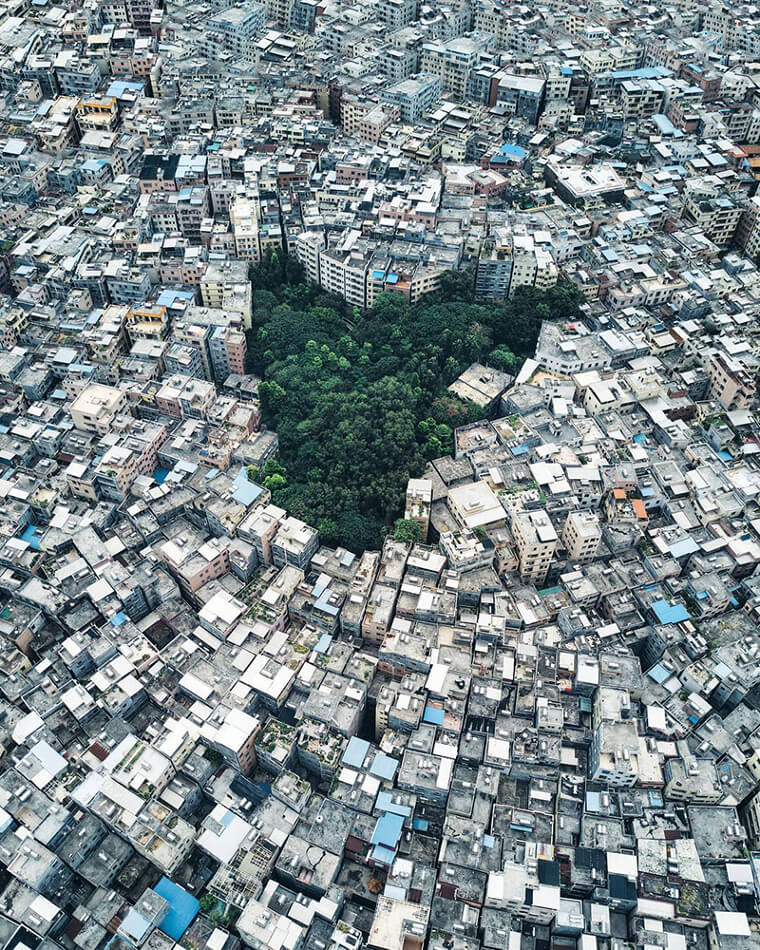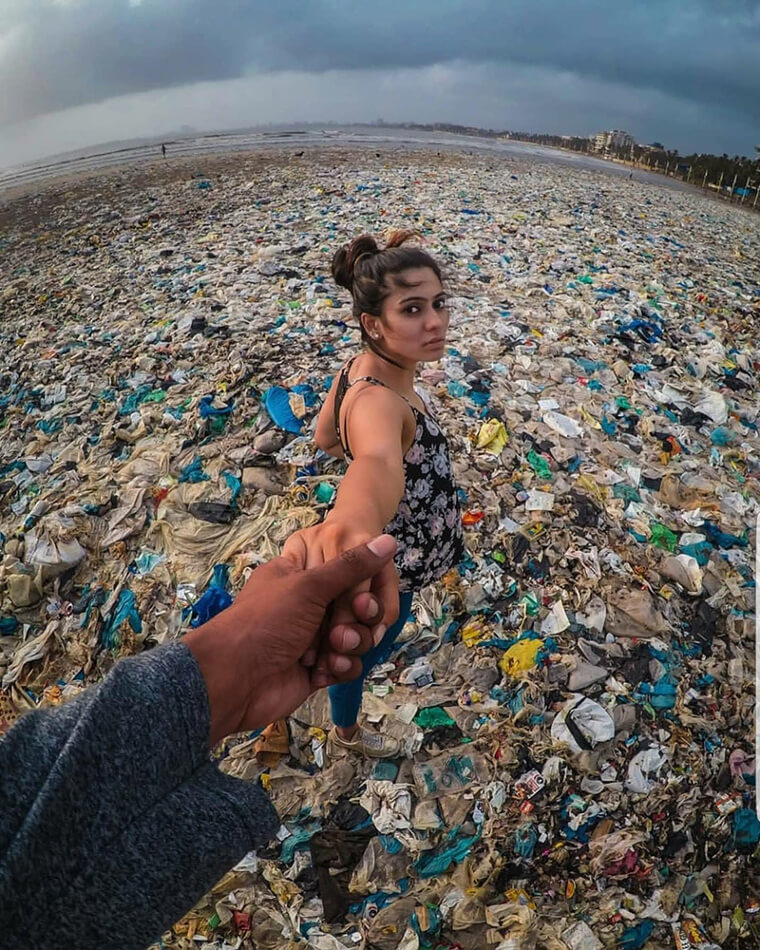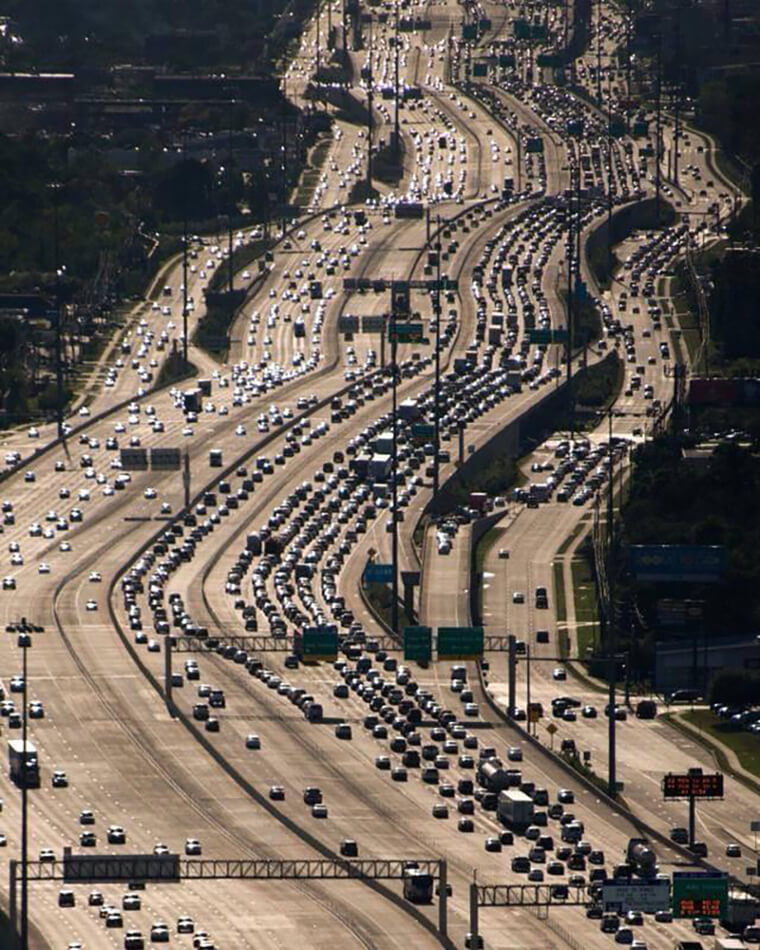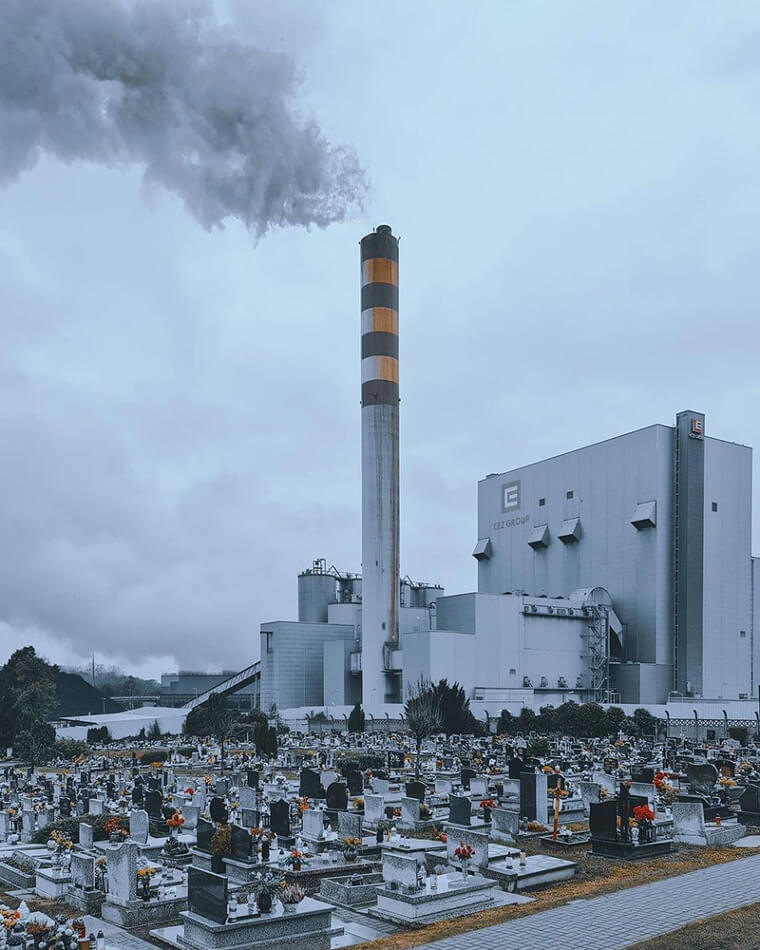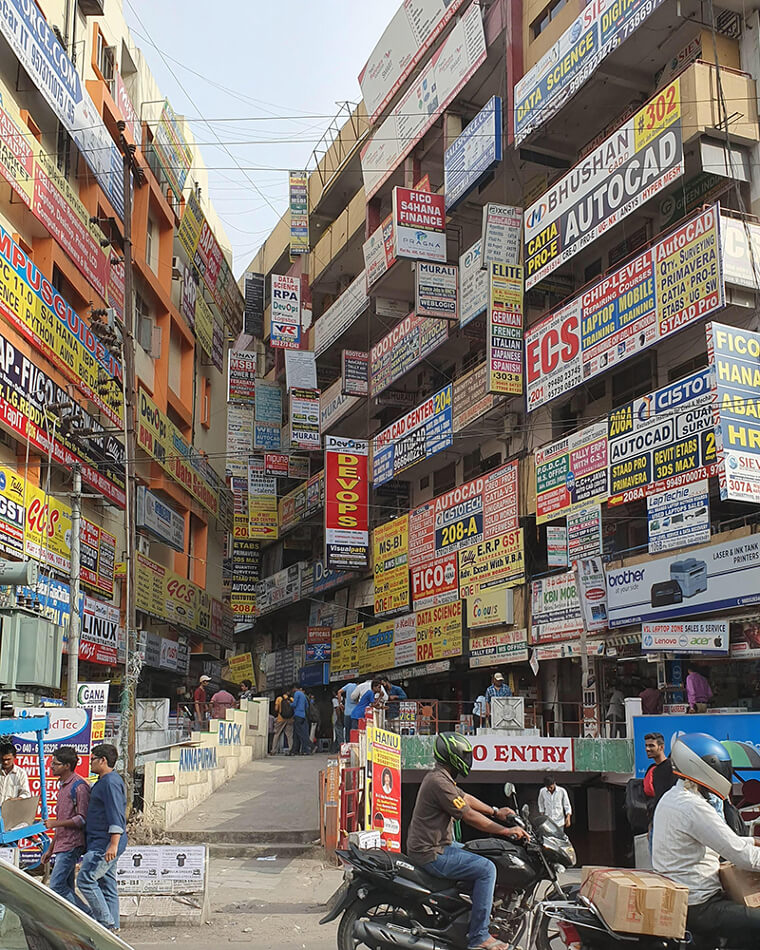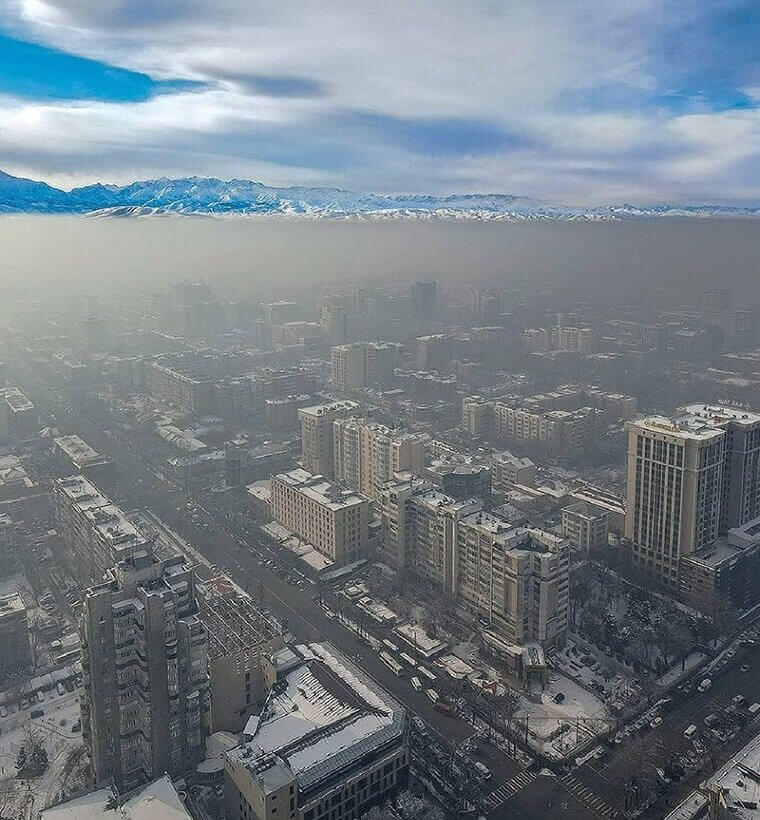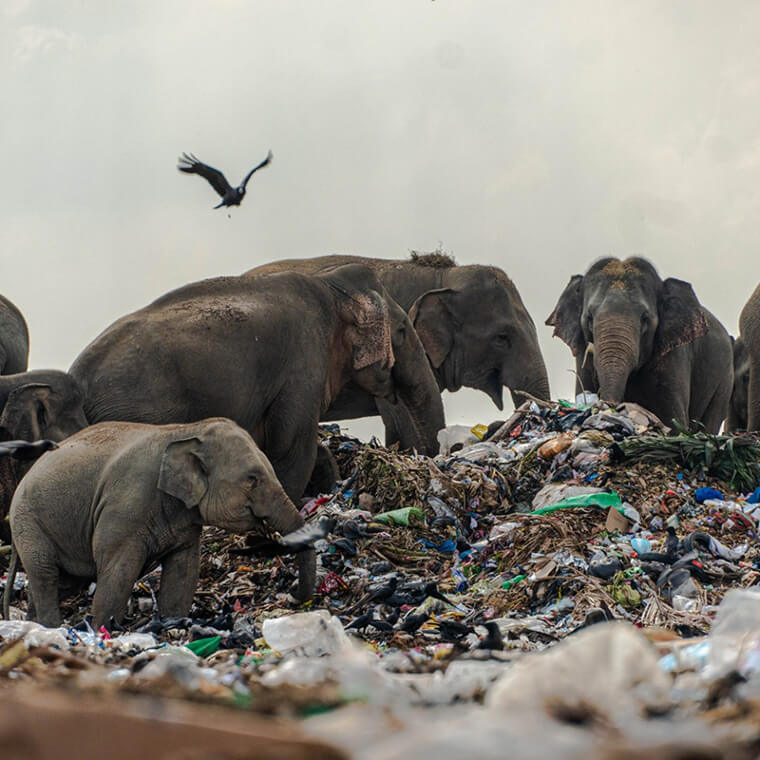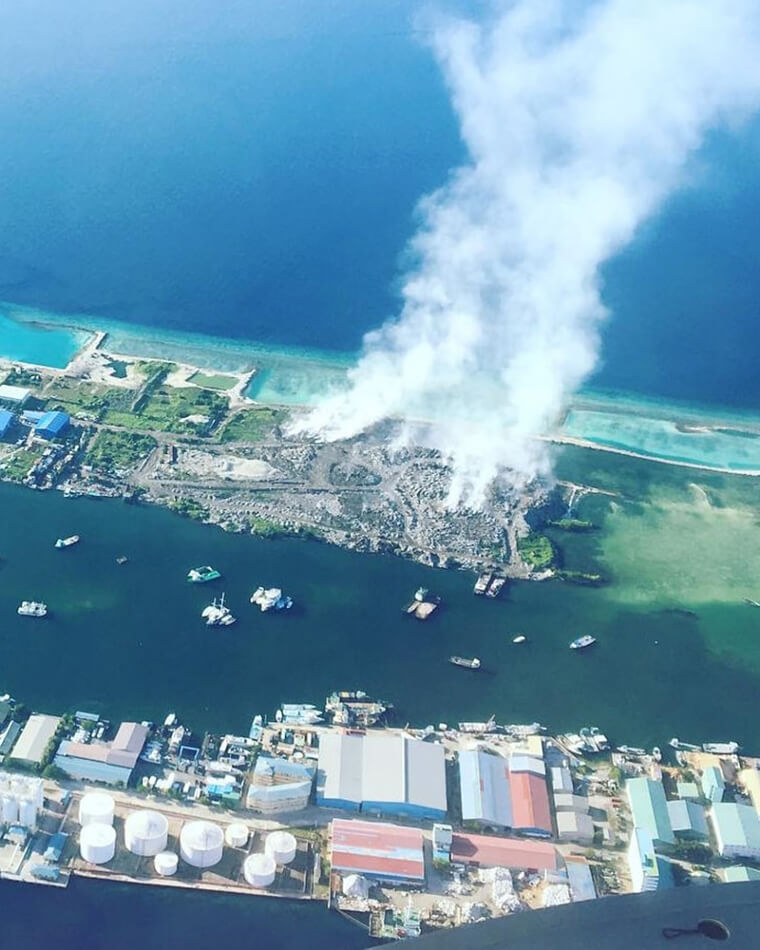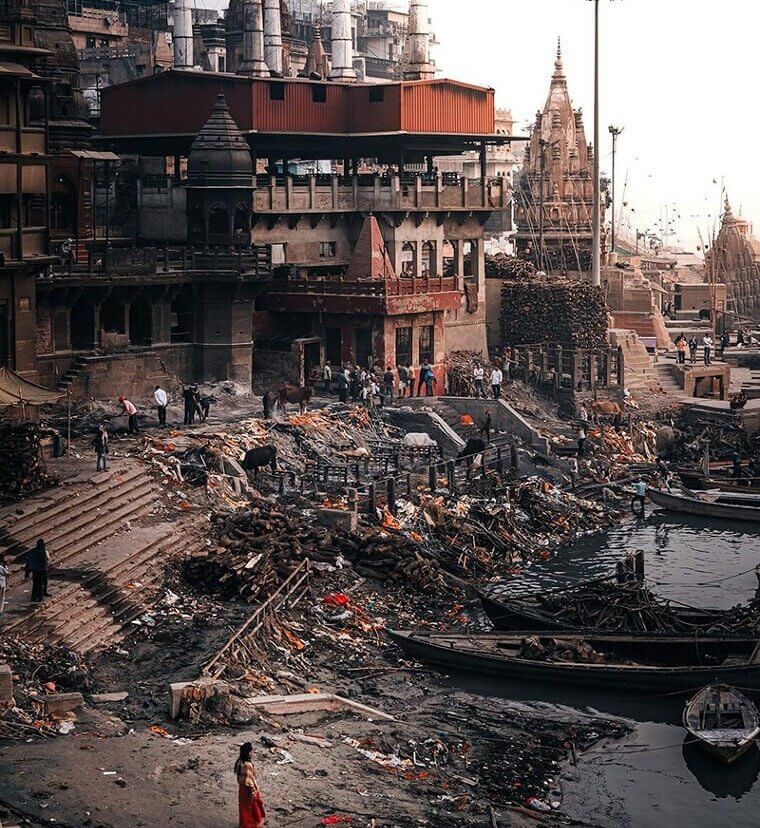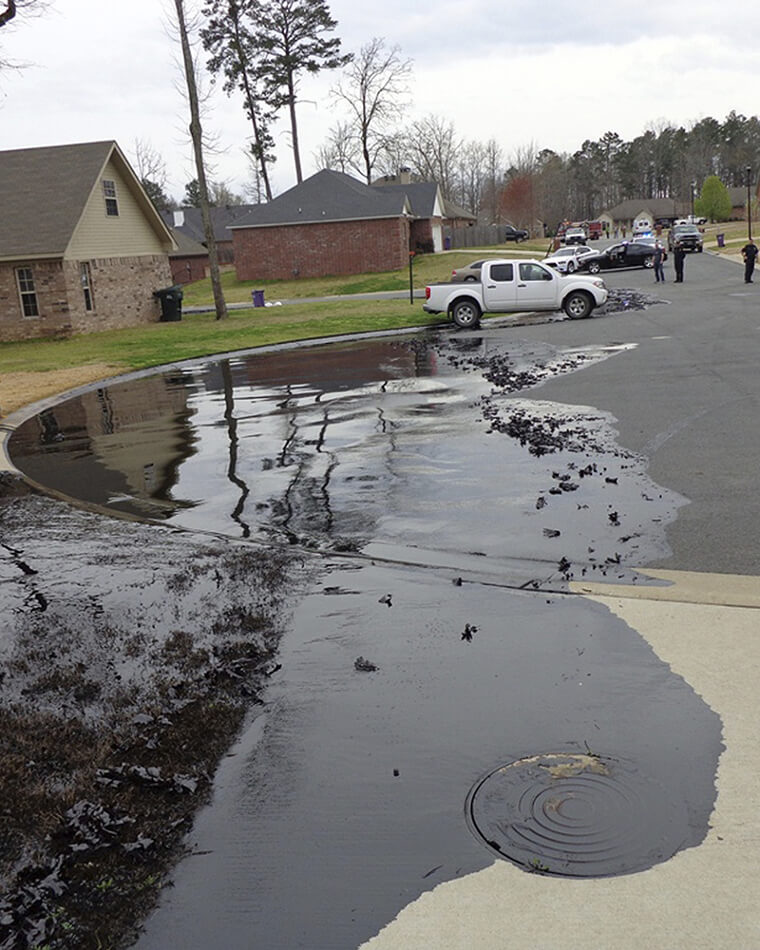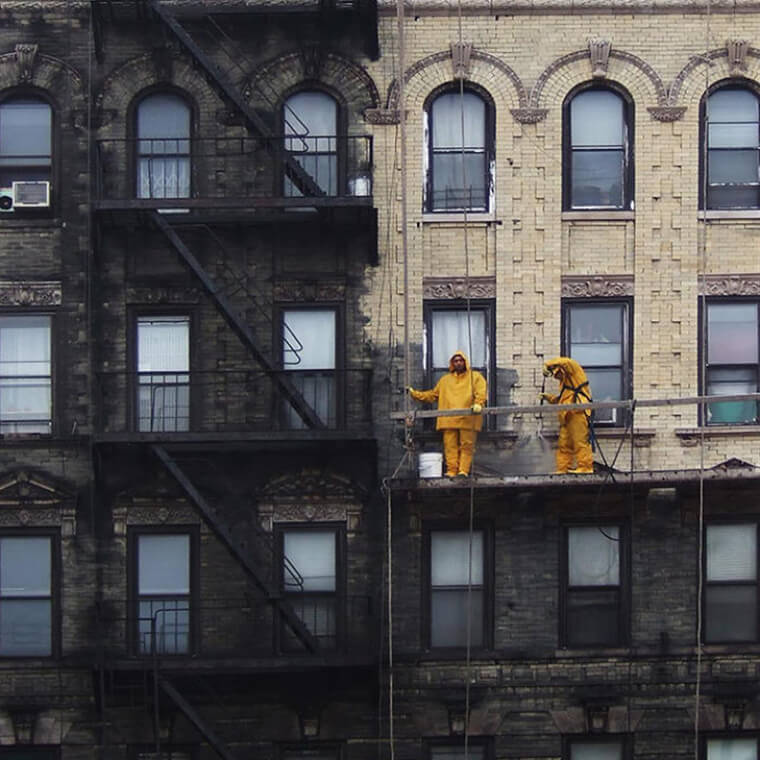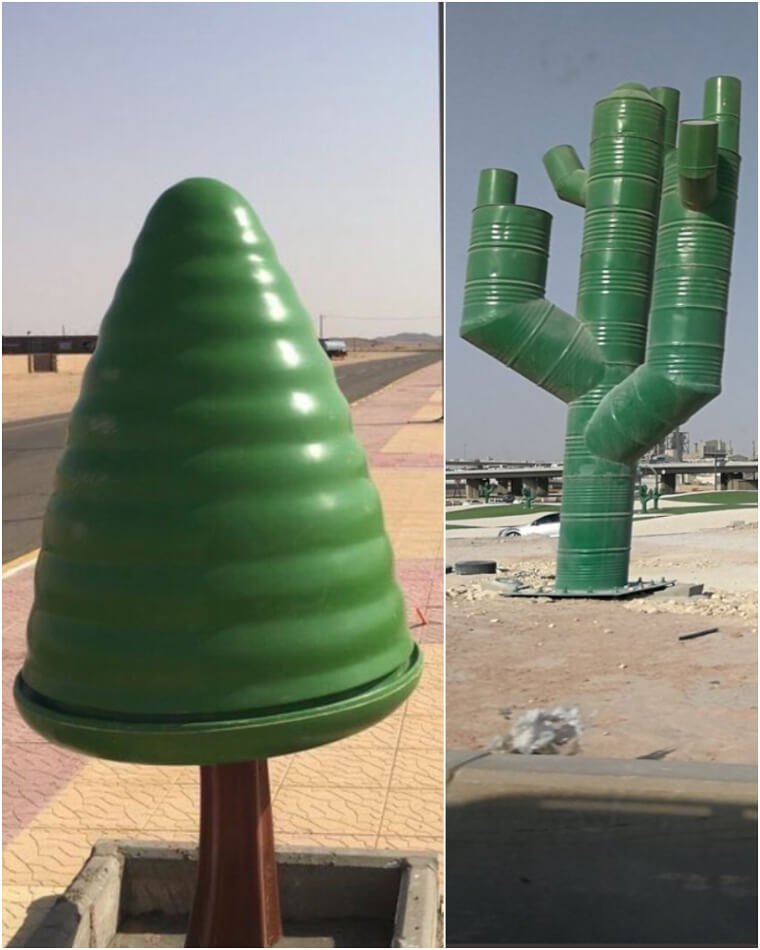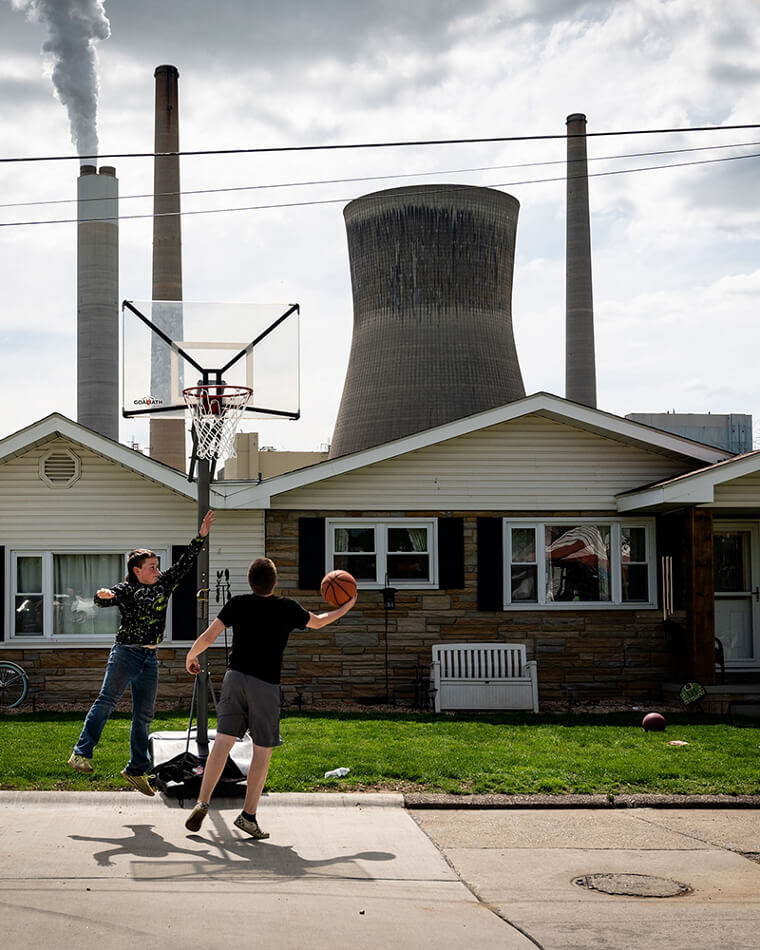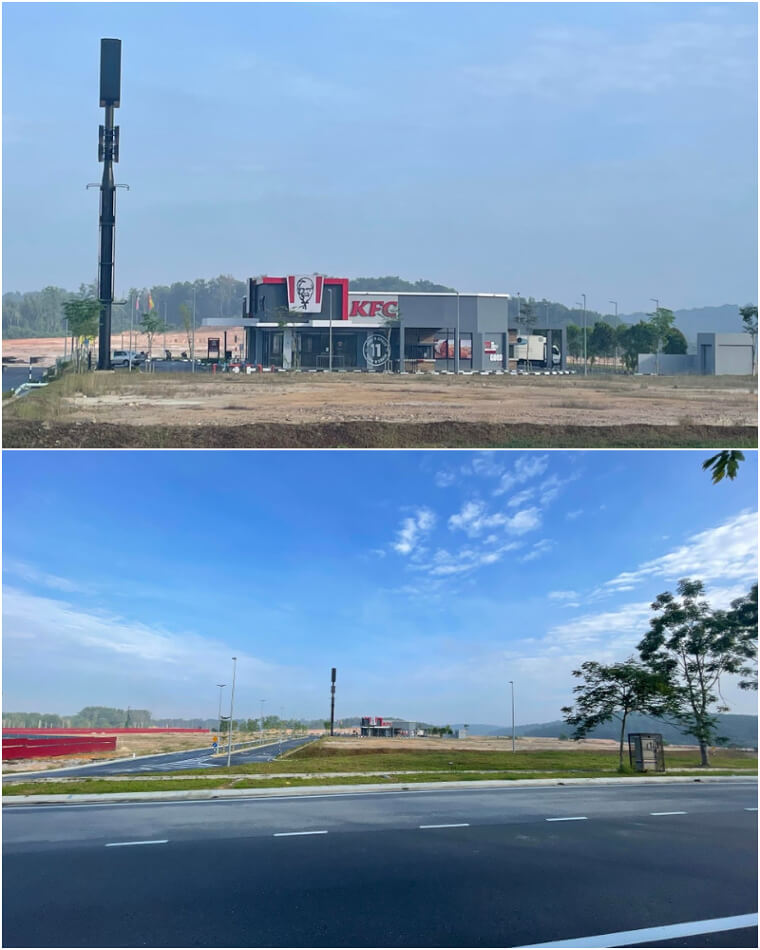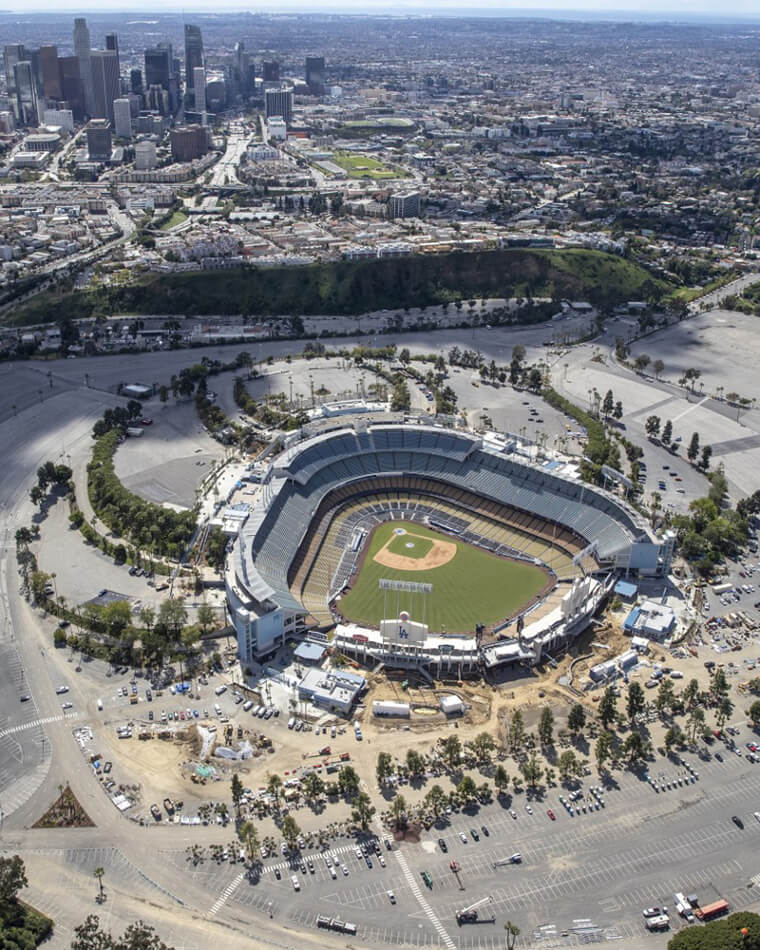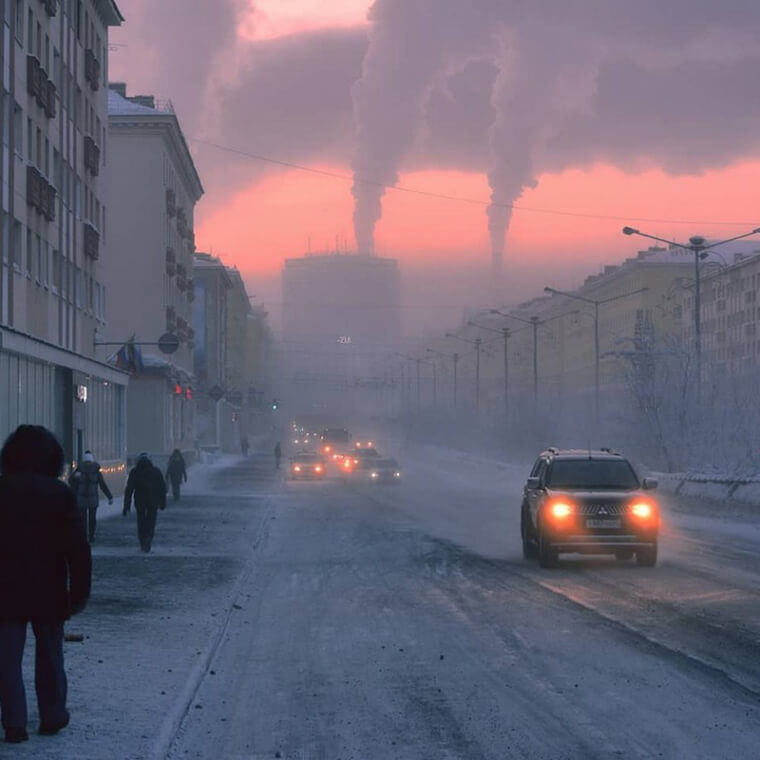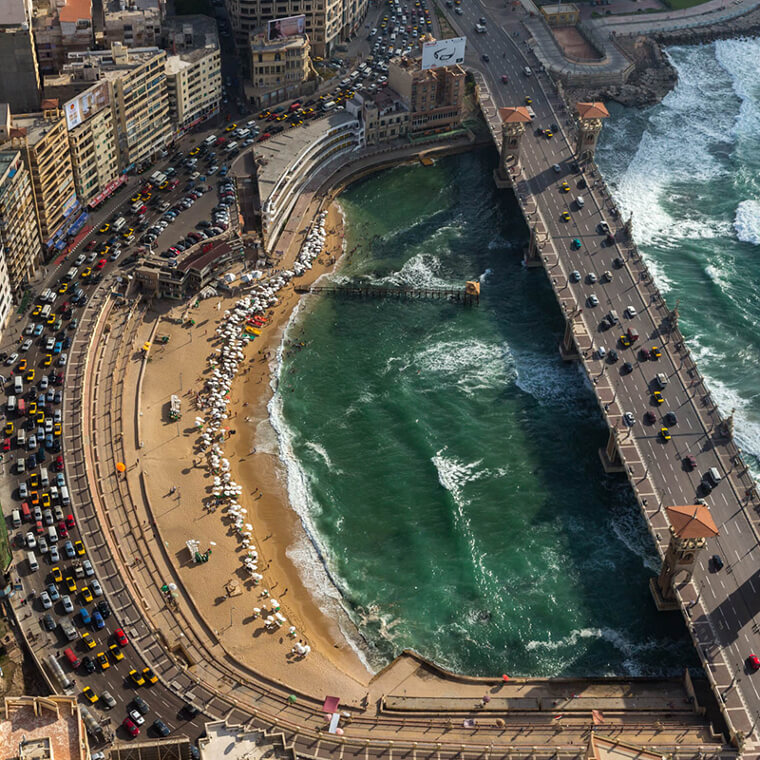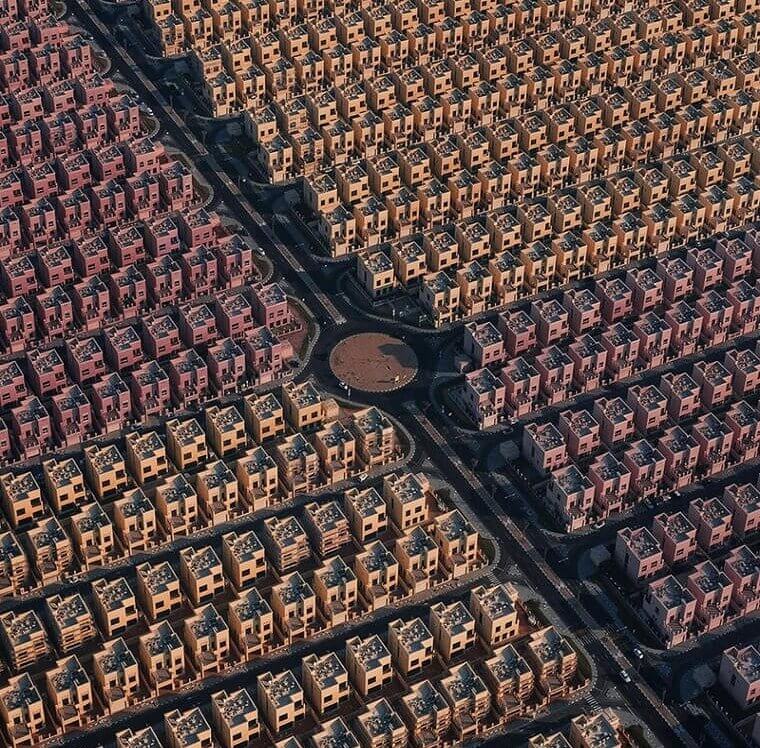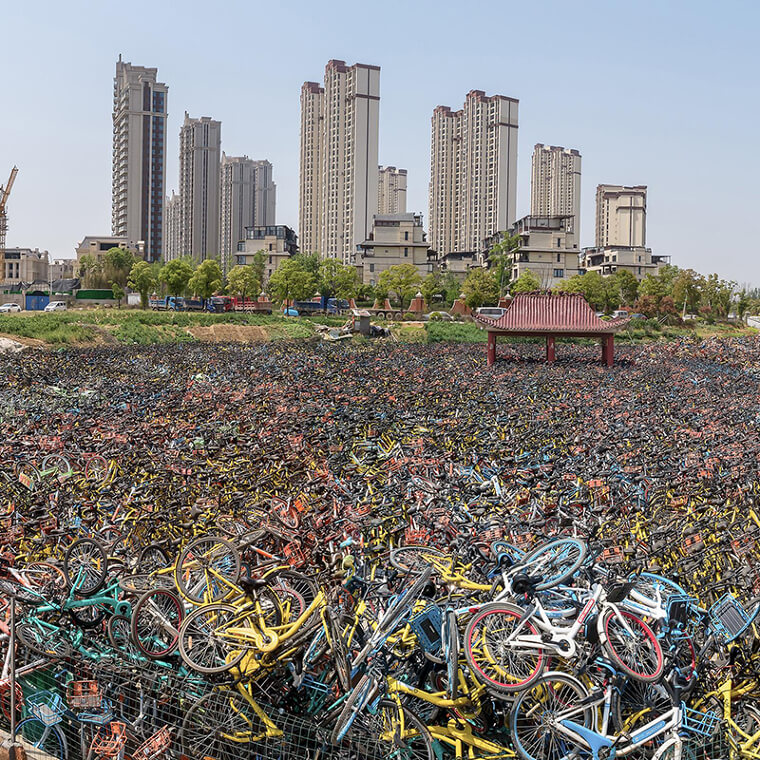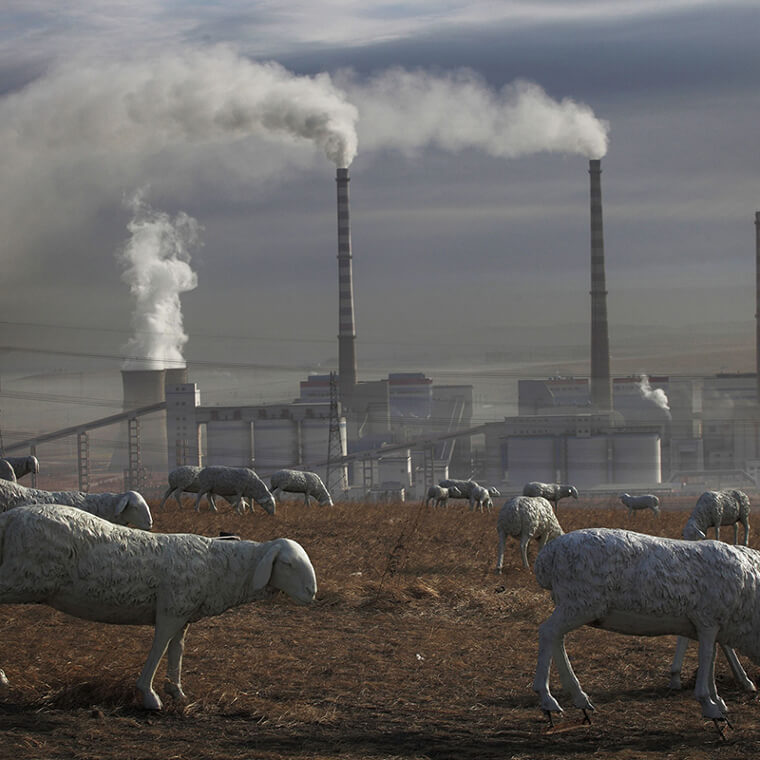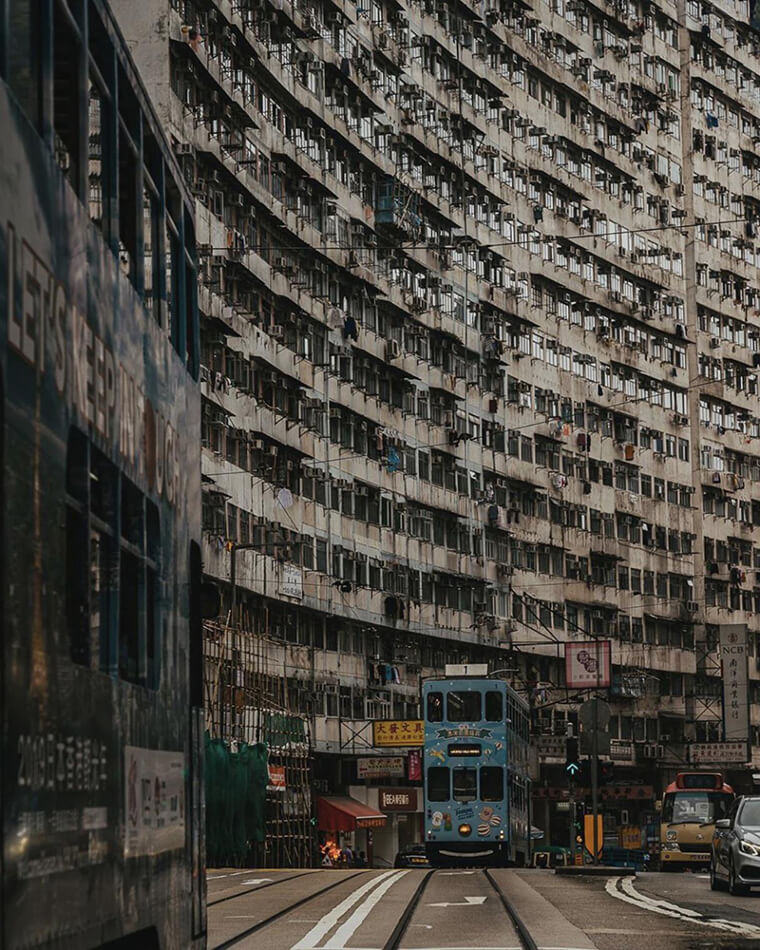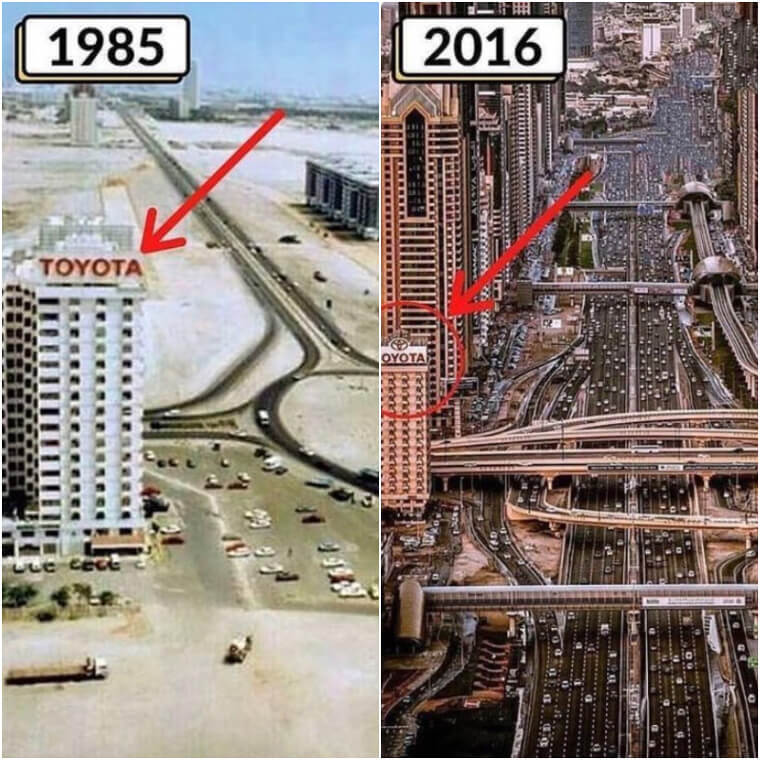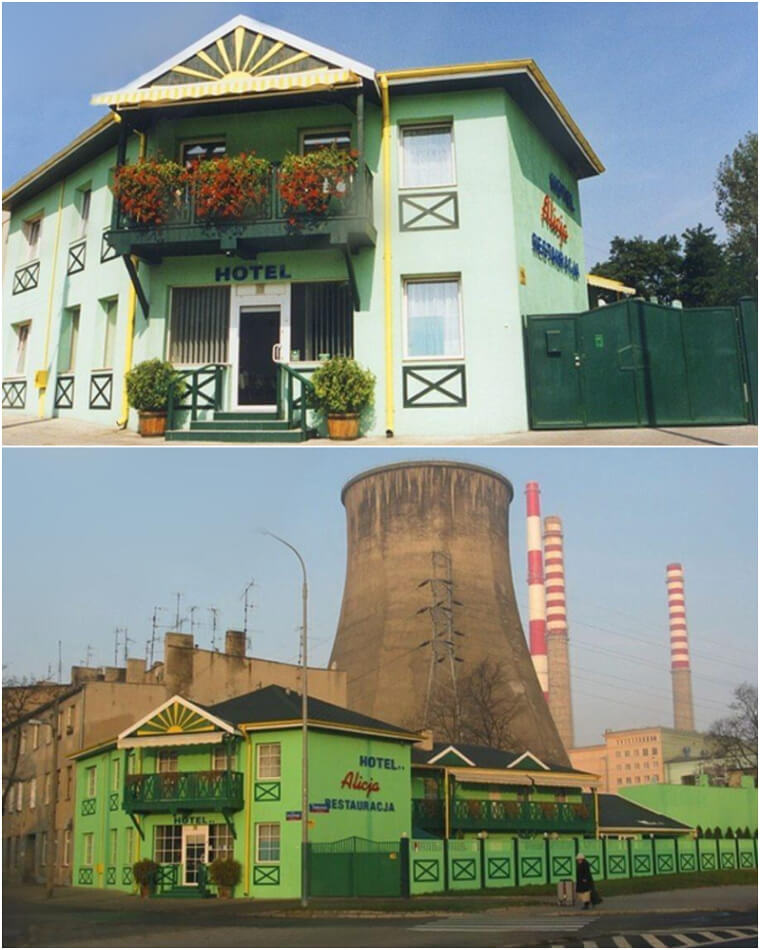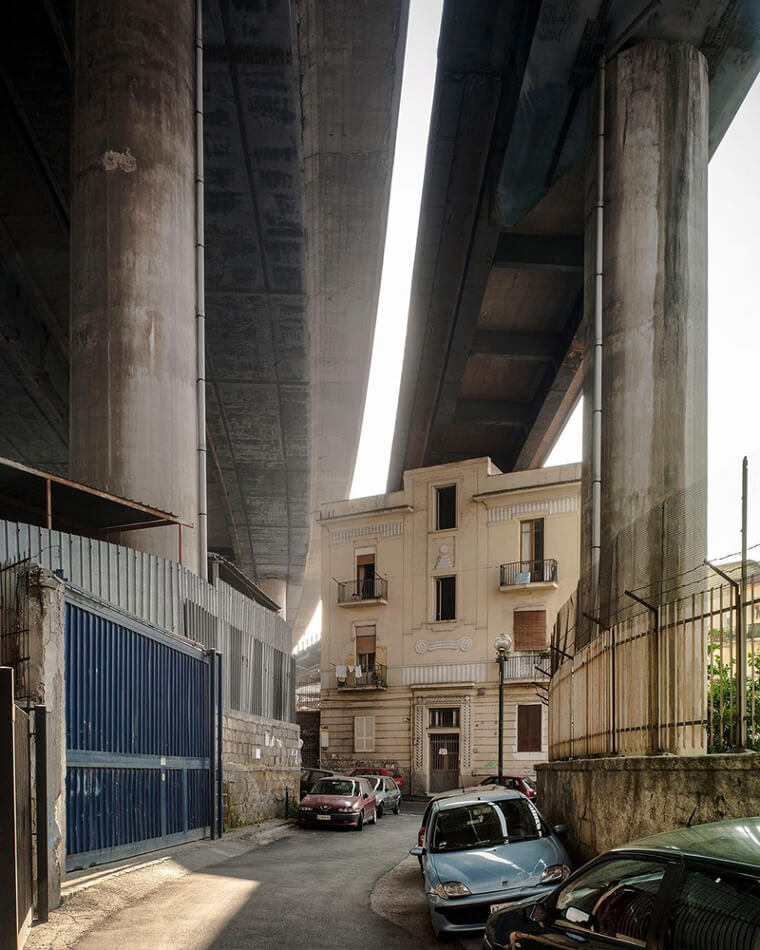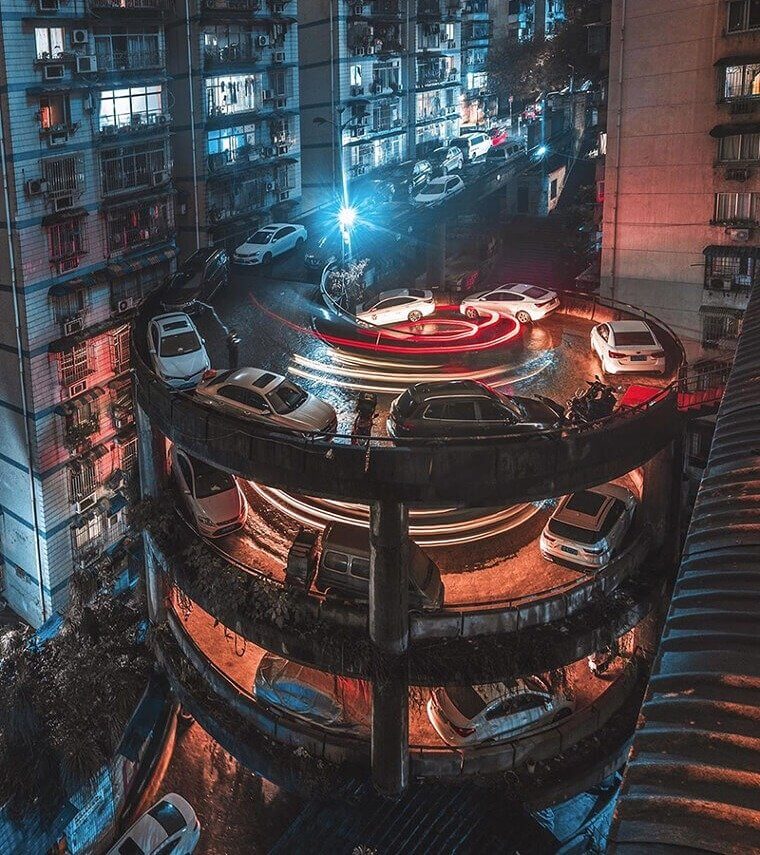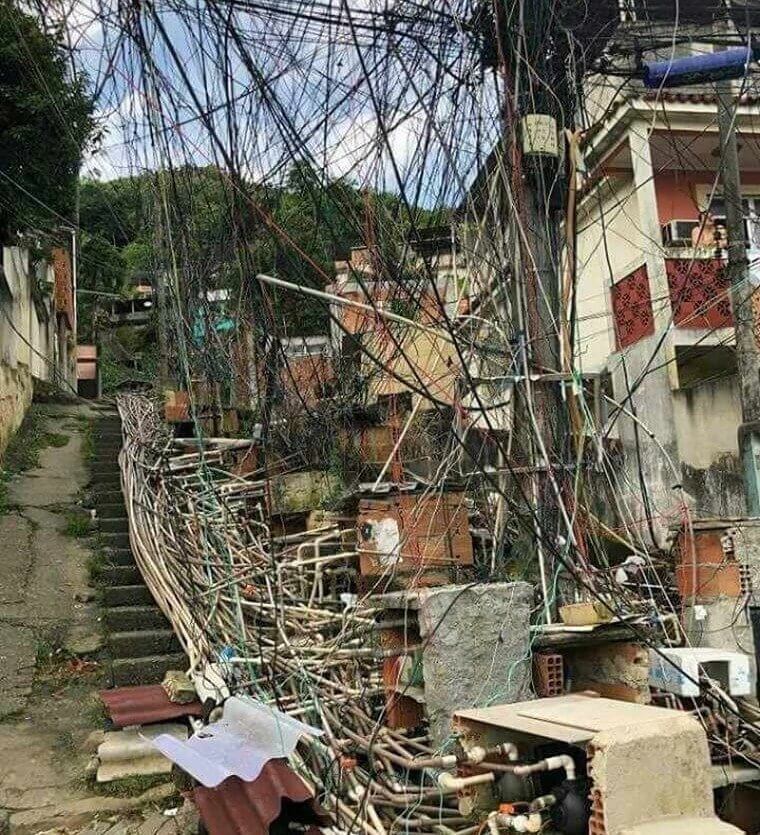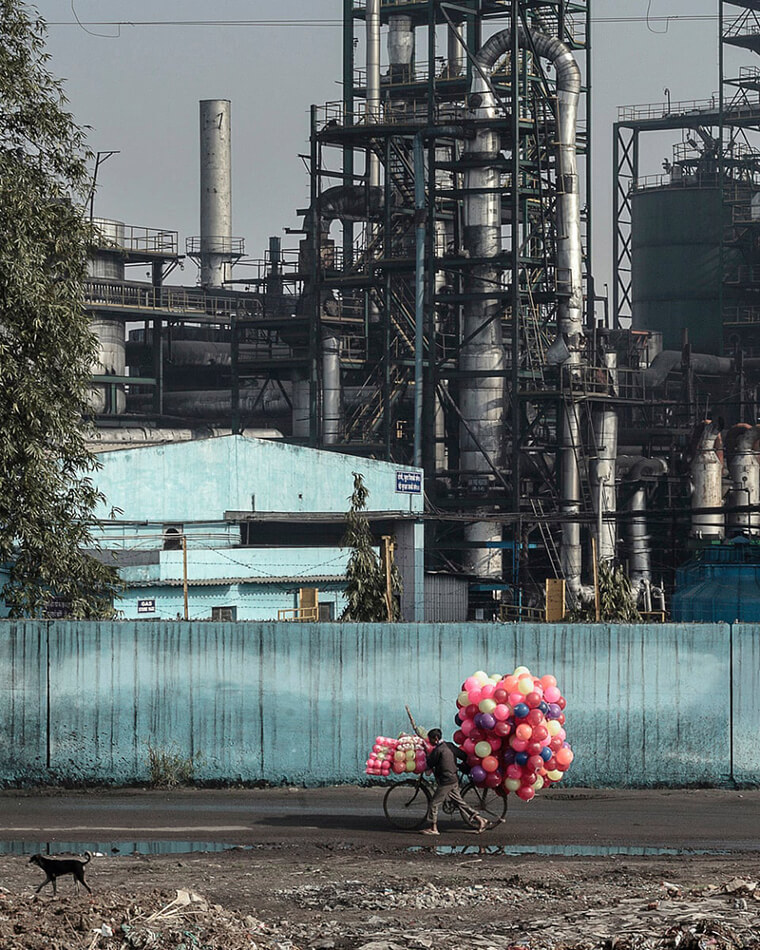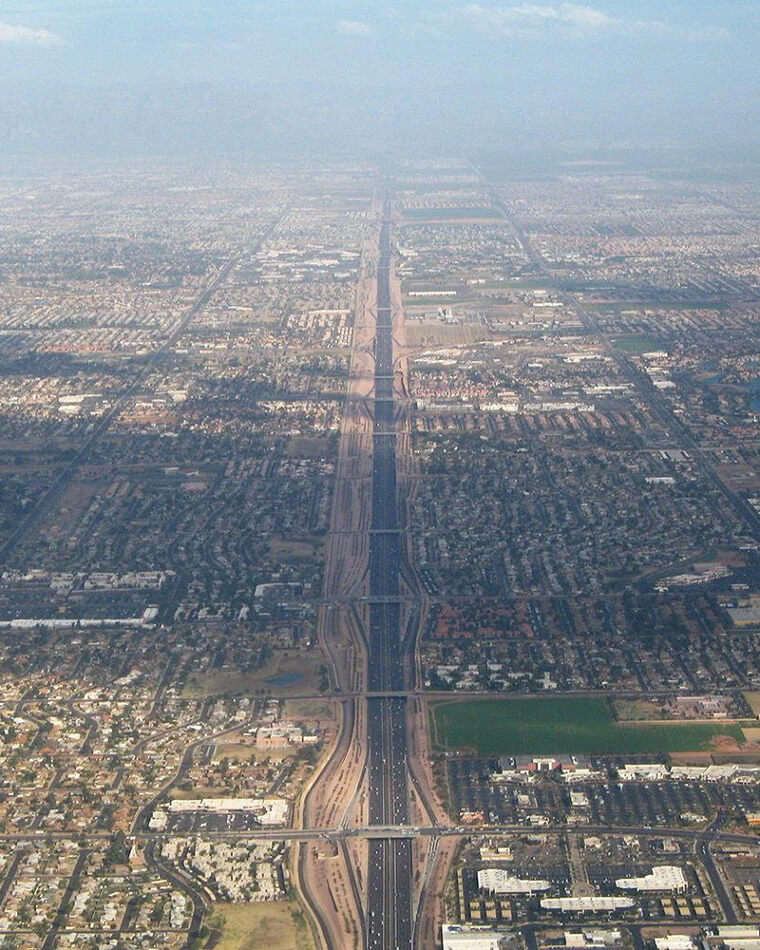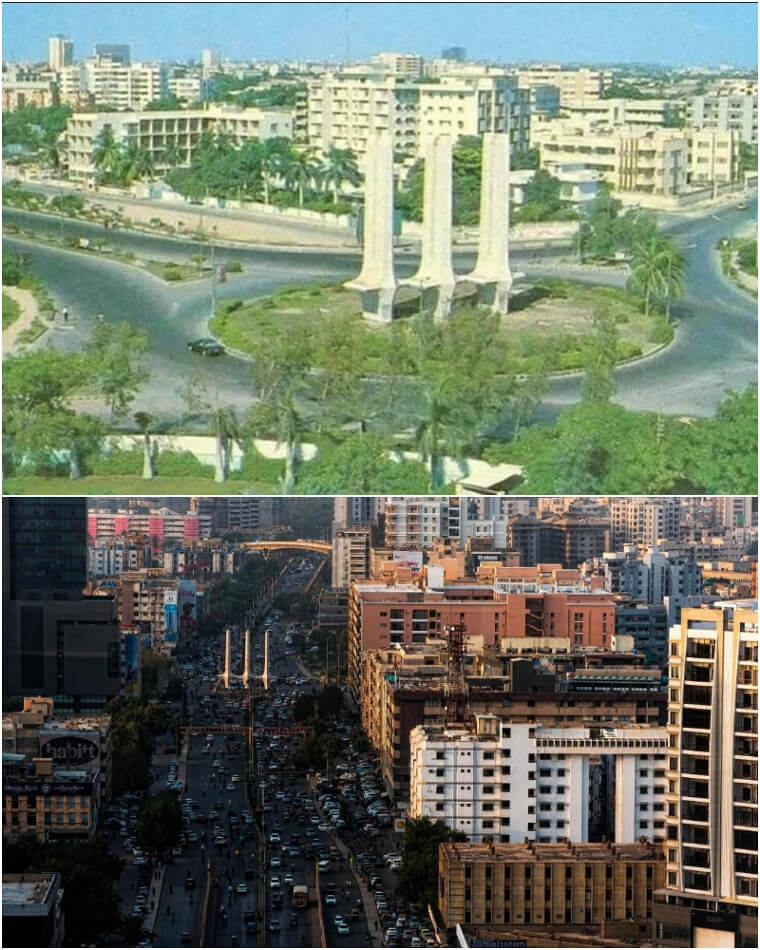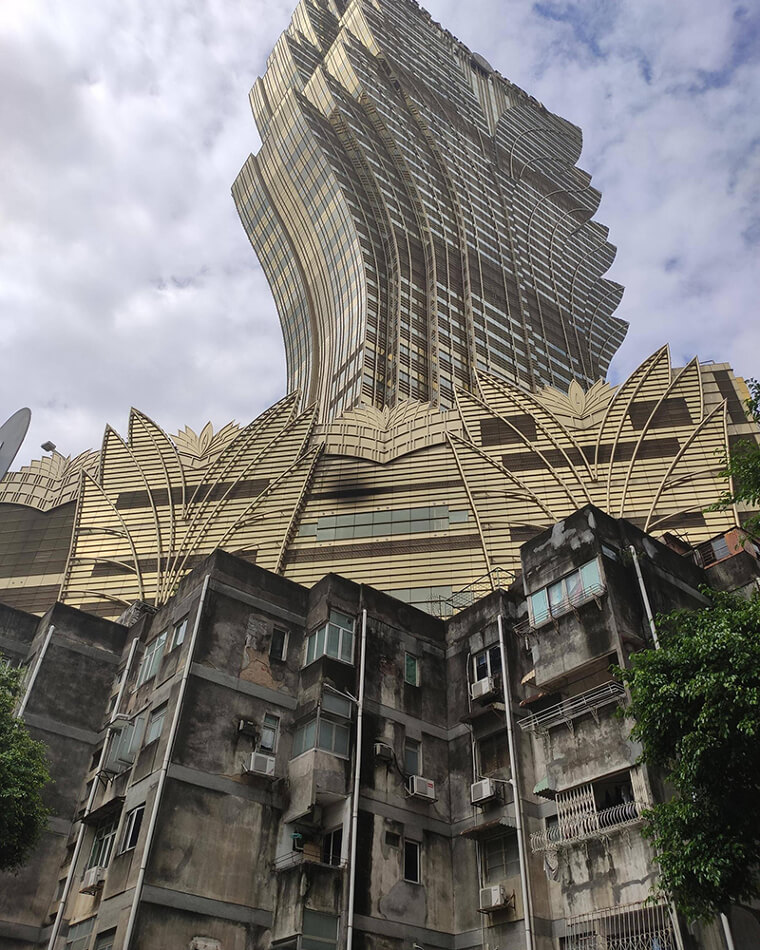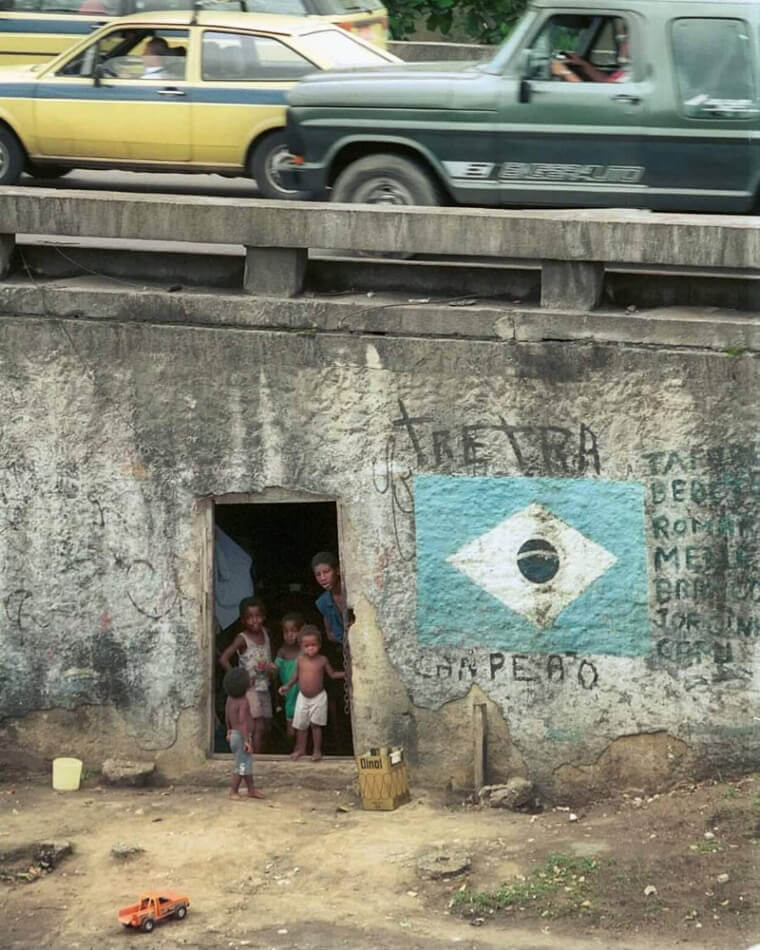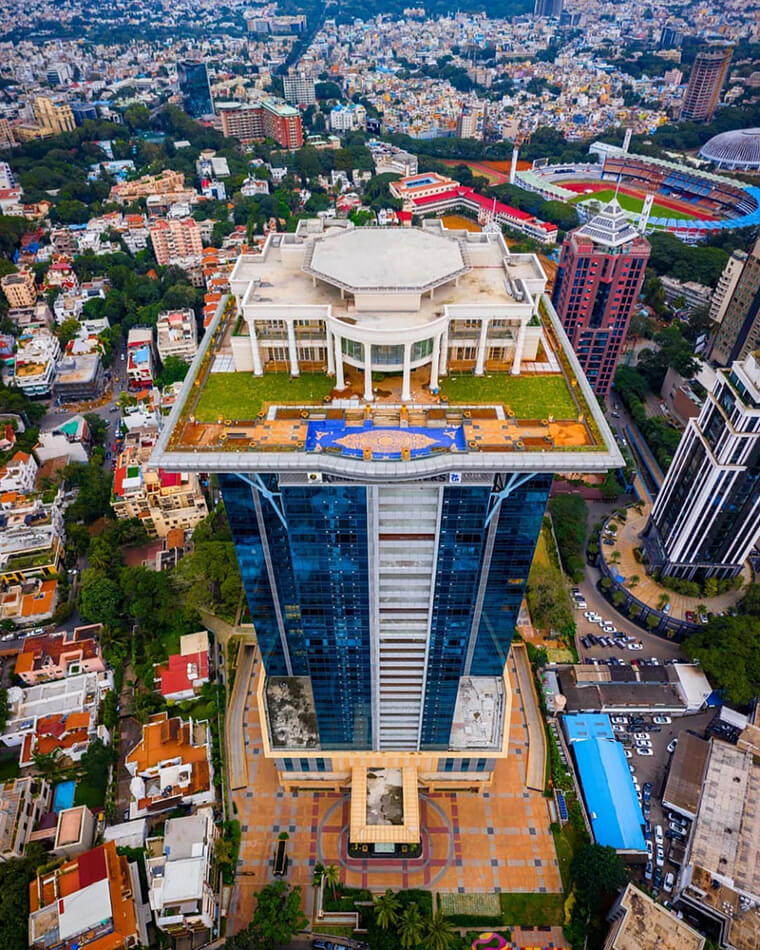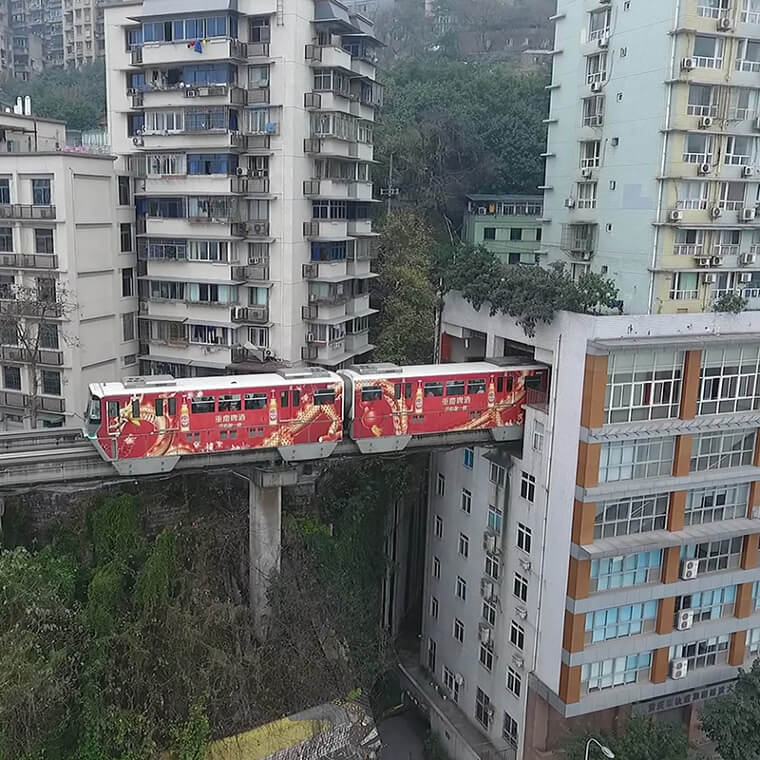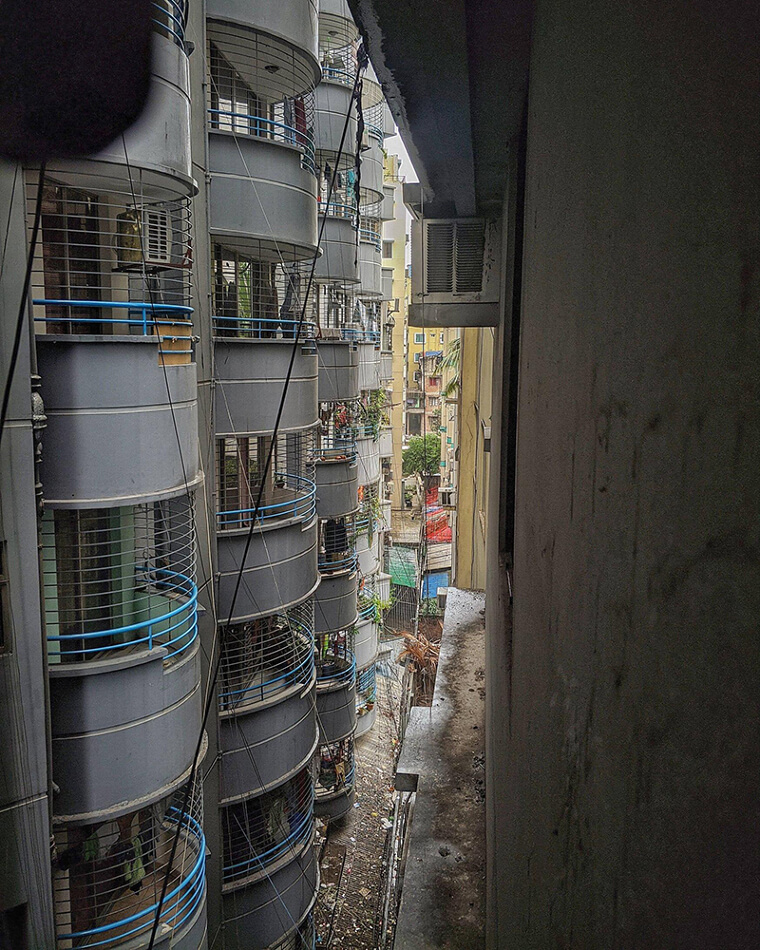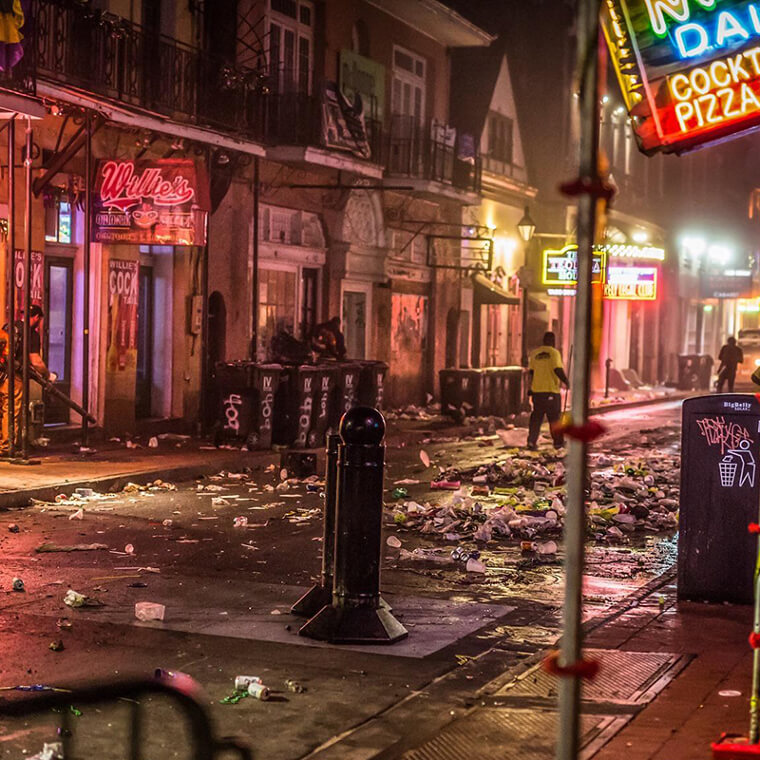Monsoon-Er or Later, We All Get What's Coming to Us
You don't have to be an expert on the Indian subcontinent to know what monsoons are - these monstrous seasonal gale-force winds accompanied by thunderous rainfall batter India every year. The thing of it, though, is that human actions affecting the environment seem to be making monsoon season worse and worse. Even if you try to put that aside, however, it's hard not to think of them as Mother Nature's little revenge.
As this photo, taken in Mumbai, shows, the monsoon winds took everything man deposited in the ocean - and gave it right back. It's not a pretty sight, but it is a stark reminder that what goes around comes around.
Take a Deep Breath Before Looking at This Comparison - but Not Literally
Delhi, India, has a very dubious distinction - consistently ranking in the world's top ten most polluted cities. In fact, India has something of a stranglehold - literally - on that list, with most of the top 20 being comprised of Indian municipalities. Many factors contribute to India's pollution problem, from traffic to fossil fuel-heavy factories. What's completely obvious are its effects, which range from respiratory problems to strokes.
And just in case you're skeptical about people's impact - these photos were taken in the same New Delhi location. On the left was Delhi during the Covid-19 lockdown, when everyone stayed indoors. On the right? Well, you can guess.
All That White Stuff in the River Isn't Whipped Cream
India's Yamuna river, much like the country's more famous Ganges river, is worshipped as a deity in Hinduism. Sights like this one, then, aren't unusual - people can be seen offering prayers at the river all the time. But what's all that white froth? Is it part of their religious practice? Maybe the country's largest bubble bath party? Hard no on both, we're afraid. The stuff those people are frolicking in is industrial waste.
The Yamuna is so polluted and toxic that it's been dubbed a "sewage drain" - and all because of the actions of the people who are supposed to venerate it.
The Heart of Our Planet, Slowly Replaced by Tenement Blocks
With a history going back over two millennia, Guangzhou, China, has a future that isn't any less promising, as the world's largest port city. With a population of 18.6 million people, it's also part of the world's largest metropolitan area, comprising 47.6 million Chinese. As you might imagine, there are no vacuums in nature - and if something moves in, something else has to move out.
Maybe this photo can provide a hint as to the losing party of Guangzhou's rapid-fire expansion. It's more than a little symbolic that those trees make up the shape of a heart, encircled on all sides by the supposed advancement of man.
Just a Casual Dip in the Ocean
Though you might not know his name, you've almost certainly seen his photographs - Russian photographer Murad Osmann kicked off "Follow Me" in 2012, when he snapped a photo of his impatient girlfriend leading him away. Now, Osmann's random photo has become a cultural trend. This snap, lampooning his creation, probably won't be showing up on his feed anytime soon. It's easy to forget, in our use-and-throw-away culture, that everything we discard carries on without us.
It'll still be there, for years, or possibly forever. Some of it even ends up on this beach we wouldn't go near without a hazmat suit. That's one brave woman.
Everything Really Is Bigger in Texas - Even the Traffic Congestion
Houston, Texas, is home to more than 2.3 million people - making it the fourth most populated city in the U.S. Small wonder - H-Town has a little bit of everything, from NASA's Johnson Space Center to the global industry - 22 Fortune 500 companies are based there. So what's not to love about Houston? Well, traffic, for one. Just look at this snap of the I-10 freeway, if you dare.
Free tip - adding more lanes to a highway to fix traffic issues is like adding more notches to your belt to fix being overweight. It's only buying you time. To think most of these people could fit onto a couple of passenger trains.
Introducing a Photo of a World Literally on Fire
This photo was taken in Salem, Oregon - not during the height of the apocalypse, as you might have rightly suspected, but at 5 pm on a completely regular day. We say "regular" because enormous wildfires have become an almost permanent fixture of the American West. The sky isn't orange because it's dusk - it's orange from the fire and smoke. Don't think it was just a freakishly hot year, either - droughts coupled with heatwaves keep getting worse.
Fire season is two and a half months longer now than it was in the '70s - and the nine worst wildfire seasons on record have all occurred since 2005.
That's Just a Little on the Nose, Isn't It?
We swear this isn't a photoshopped image from a book about the most heavy-handed metaphors in human history. This scene, of a smoke-belching factory right next to a cemetery, exists exactly as you see it here in Chorzow, in central Poland. In fact, in the past Chorzow was known as a regional center of heavy industry, big in coal mining and the energy sector, before environmental concerns led to its reduction.
Now sure, you might say that a polluting factory is better located next to a cemetery than, say, a school, but graveyards aren't really for the deceased - they're for those they left behind.
Imagine Looking for One Specific Business in That Absolute Mess
Don't let the myth of call centers fool you - India is the world's number one country in producing engineering graduates. In fact, it's home to no less than a quarter of all engineers on Earth! How's that for unskilled labor? Of course, the flipside of that coin is that they all need places to master the tools of their trade. This single street in Hyderabad, in the country's south, gives a dizzying new definition to "visual pollution."
Seriously, how can that be even slightly effective? The one dude to do a sign in black-and-white Comic Sans is going to get ALL the business.
Happiness Is a Warm Blanket, Charlie Brown - But So Is Pollution
It might not immediately be obvious you're seeing a single, undoctored photo here. What you're seeing, in fact, is the thick blanket of smog hanging over Bishkek, the capital city of Kyrgyzstan - the world's eighth most polluted country. Not to be outdone, Bishkek often finds itself topping the list of the world's most polluted cities. Pollution there, measured in ASI (air stress index), often exceeds 1,000 - when anything above 300 is considered "hazardous."
Bishkek is nestled in a valley, which traps polluted air, but it doesn't help that most homes are still heated by burning coal. Basically, to breathe freely in Bishkek you need to board a plane.
Man, This New Version of the Lion King Is the Worst
We sincerely apologize if we've disturbed anyone, but hiding from the truth doesn't make it go away. Asian elephants are officially endangered, and this photo highlights part of the reason why. Sure, poaching them has always been a problem, but the loss of habitat has always been the biggest culprit. Sri Lanka reportedly has the highest density of elephants in Asia, despite the fact they're waging a constant - and losing - battle against man.
This photo is perfect evidence, showing a herd of elephants who lost their natural habitat to people being reduced to foraging for food in a garbage dump, where they're likely to eat plastic and other dangerous materials.
An Island Paradise's (Very) Dirty Little Secret
If you've heard of the Maldives, the image conjured up is probably of an island paradise. And rightly so, as this chain of islands in the Indian Ocean came from nothing to become one of the world's top tourist destinations. Bleached-white beaches, deep blue waters, coral, fish-- How could we possibly ruin this for you, you wonder? Well, meet Thilafushi, the Maldives' artificially created garbage dump island.
The country, it appears, doesn't really have a waste disposal strategy other than taking the trash from all the other islands, and dumping it at Thilafushi. So what all gets dumped into those pristine waters? Batteries, asbestos, and lead, among other things.
India's Portal Into the Afterlife Doesn't Look Very Appealing
Varanasi, in northern India, is the holiest of the seven cities viewed as sacred by Hinduism's 1.2 billion believers. According to the faith, existence is a continuous cycle of (re)birth and death, which may be broken only by cremation in specific places - one of them being Manikarnika Ghat. Now, a "ghat" is a sacred riverfront, where the faithful come to practice their religion. And yes, that includes cremation.
At this point, you might be wondering whether cremating bodies so close to a river people bathe in and drink from is a good idea. We're with you. You see all those ashes, right down to the waterline? They're not just from firewood.
Mayflower, Arkansas - Where the Streets Run Black With Oil
On March 29, 2013, the residents of Mayflower, Arkansas, awoke to a peculiar kind of morning. As it happened, a pipeline carrying crude oil from Canada ruptured, releasing almost 3,200 barrels of so-called "black gold" onto Mayflower's streets. Sounds like payday for the locals, right? Just bring a hose and a container and start collecting! Well, not exactly. Evidently, crude oil isn't that great for-- anything, really, except gas-guzzling cars.
Apart from polluting the city's air, it also almost seeped into nearby Lake Conway, home to many fish species. Such a disaster was averted only thanks to the speedy actions of first responders. Still, everyone needs an SUV, right?
That's Not a Fresh Coat of Paint
It doesn't matter whether you've ever physically been there or not - you're guaranteed to have an image of New York City in your head. It was put there by Hollywood, by countless movies and TV shows. But just like most everything else about Hollywood, that image is also mostly fake. NYC, first and foremost, is dirty. We don't mean trash, necessarily. We mean the dirt accumulated from the lives of 8.8 million people.
That grime? It's not even new, but rather a remnant of long-gone industrial coal fires. That's how dirty the city is - even the buildings haven't had a shower in decades.
Ah, Trees. Yes, We Have Seen Many of Your Earth Trees
No, we assure you, these aren't photos from the world's worst theme park, or the off-off-off-brand version of Legoland. They are, rather, the culmination of the completely real, completely serious efforts by officials in Saudi Arabia to combat the fact that the country is a desert. Since trees don't really do well in those, local officials in the Qassim province, the country's richest as it happens, decided to get creative.
The result is literal plastic trees. A country whose entire economy is built on fossil fuels has taken to putting up plastic trees? There's a joke in there somewhere, but we're too scared to make it.
Life, as It So Often Does, Will Carry on Regardless
This photo was taken in Poca, West Virginia, and shows a couple of kids playing some b-ball on the street. It would pretty much be the stuff Norman Rockwell paintings are made of - if it wasn't for that enormous coal-fired power plant behind them. It's not, we've been told, an uncommon sight. In fact, many of the locals living along the Kanawha Valley have taken to calling it "Chemical Valley."
Here's a fun fact (fun if you don't live anywhere around them, that is) - even putting pollution aside, coal plants actually emit more radiation than nuclear ones.
They Paved Paradise and Put Up A--- KFC?
Context is king. This photo, for example, just seems to show a KFC location out in the middle of nowhere, and little else - until you learn the context behind it. Buckle up, because you're about to get really, really angry. Apparently, this was taken in Malaysia, at the site of a former rainforest. Why "former"? Because it was all cleared to make way for development, starting with this sad-looking KFC.
If the idea of tearing down rainforests for some fried chicken isn't infuriating enough, consider that the forest was home to a delicate, intricate ecosystem built up over literally millions of years - and now it's gone.
L.A. Finally Won the World Series - Now All They Need Is Some Parking Garages
Take me out to the ball game, as the famous song goes. What that song neglected to mention was how depressingly wasteful baseball would become. You don't have to be a baseball fan to recognize Dodger Stadium, Los Angeles's iconic ballpark. Also immediately noticeable is the 40,000-space carpark around it - seemingly an admission of giving up trying to have decent public transportation in L.A.
We mean, an underground parking garage or two might've been built, taking up a fraction of the space. Or, if the Dodgers' former owner has his way, a weird aerial gondola system.
Quite Possibly the Worst Place to Live in on Earth
If Santa Claus really does live in the North Pole, we hope and pray it's nowhere near Norilsk, Russia. Located within the Arctic Circle, Norilsk is one of only two large cities in the Arctic's continuous permafrost zone - where the soil is permanently frozen. Snowfall for 270 days a year? A sun that doesn't set for 65 days, then doesn't rise for 45 days? Nonsense. What's really likely to cause the demise of anyone living in Norilsk is nickel.
Specifically, local factories that extract nickel ore cause acid rain to fall on the town's poor residents. In fact, the ground itself has become so polluted with metals like platinum that now it's being mined itself!
The Beach Is Nice, but the View Could Honestly Be Better
Legend has it that Alexandria, Egypt, was founded by none other than Alexander the Great. We have a feeling that if Alex saw what's been done to the place since, though, he might be taking it back. A thriving destination for tourism, the influx of people has also meant an influx in traffic. Here's one creative solution - build a bridge over the Mediterranean, because nothing says "untouched pristine beauty" like a six-lane highway.
To make matters worse, the beach is cut off from the city by a road on the other side as well! How are you supposed to get to the water, even if it is overflowing with trash thrown by the people driving overhead?
Whoa, Someone Went a Little Overboard with Copy and Paste
There's no way that's real, you probably think. "Nobody will build that many houses that look EXACTLY the same." Well, the joke's on you - but also on all of us as a species. This is a genuine photo of the Nad Al Sheba 3 neighborhood in Dubai, the United Arab Emirates. The ruling sheikh, apparently, gifts a villa completely free of charge to newly married couples.
Bills and utilities are all free for the duration of their residence - all so they can have tons of kids and increase the population. Those who do then get even better homes. Geez, it's like a reverse Hunger Games!
What Happens When an Ultra-Popular Hobby Falls Out of Popularity Overnight
The centers of many cities in the U.S. and Europe have been flooded in recent years with e-scooters and bikes. The logic's behind them is great - just rent one to get around freely without polluting the environment in your huge car. But what happens when a fad, as fads do, dissipates? Beanie Babies weren't around forever, and apparently, neither are bike rentals. For a time, though, bike-sharing was China's biggest craze.
A single company, in fact, supposedly made more than a million bikes per month. However, modest demand - coupled with infrastructural issues - led to mass graveyards like this, of rusting bikes doing to the environment exactly what they were supposed to prevent.
We Don't Know What You Thought, but Those Sheep Aren't Helping
There's something delightfully Orwellian about the way authorities in Holingol, Inner Mongolia, China, have leaned into their serious pollution problem. Holingol "boasts" various chemical, power, and coal industries. Together, they combined to form a Voltron-like mega robot, only it's made of pollution. The grasslands nearby have become so toxic, then, that it's completely impossible for any livestock or wild animals to graze there. So did the government fix the pollution problem?
Of course not, silly. They just made statues of sheep, horses, and camels and sprinkled them in the area to make it seem like being there is NOT fatal. Kinda shooting yourselves in the foot there, guys.
This Isn't an Image from Judge Dredd - It's Just Present-Day Hong Kong
Life's all about perspective, so allow us to give you some - Hong Kong, China's financial and business center, lies on territory that's a little smaller than San Antonio, Texas. The real difference, though? While San Antonio has less than a million and a half people living there, Hong Kong has 7.5 million - making it the fourth most densely populated territory in the world. We think this photo, of a random Hong Kong street, does that detail justice.
Just look at that apartment building, which both dwarfs that bus and seems to go on forever. What's life like when you have thousands of next-door neighbors?
Well, at Least That One Car Company Had Staying Power
Dubai, in the United Arab Emirates, has a lot going for it. The world's tallest building? Check. The second-largest amount of five-star hotels in the world? Check. Business, finance, and trade epicenter? Check, check, and check. Yes, there's not a lot you CAN'T find in Dubai these days - except maybe someplace quiet. Starting as a tiny fishing village, the city's population has exploded - not at all unrelated to the oil boom enjoyed by the UAE.
While oil's supposedly only a fraction of the country's economy these days, all those cars are a stark reminder of how that enormous change was made possible in the first place.
An 'Instagram Vs. Reality' Situation
We found these two photos to be a fascinating exercise in the art of marketing. They're both obviously of the same hotel, located in Lodz, Poland. It's just that one was taken at a flattering low angle, while the other revealed that the place is nestled against a grim-looking power station. Nothing against this establishment, mind you - we're sure it's lovely. We just found it a little funny to be bunking up with a cooling tower.
The hotel has since been redesigned and now looks modern and sleek - but those tower and smokestacks, unfortunately, have remained exactly the same. Bon voyage!
This Is What Happens When You Don't Call Dibs
Naples, in southern Italy, is known as the birthplace of pizza. It's also known as the hub of the Camorra organized crime society, which you might remember from the 2008 Italian crime flick Gomorrah. Don't let that sour you on Naples, though - it really is one of Italy's most beautiful cities. Just look at that quaint little single-family home. Okay, bad example - it's a little overshadowed by that highway overpass.
There's nothing wrong with the overpass per se - it just feels wrong that it took that house's claim to blue skies, despite the fact that the house was without a doubt there first.
Some Don't Have to Go Far for Their Own Private Dystopias
Chongqing is a city in southwestern China, and by "city" we mean it's roughly the size of Kentucky. Chinese ingenuity doesn't limit itself to cutting manufacturing costs, though. Check out this helicoidal street. To Western eyes, it might seem like a parking garage, but it's a literal street - with traffic going from the top to the bottom in circles. Looks like a super cool way to save space, right?
Right - until you realize people live just nearby, and have to face screeching tires and brakes and blinding headlights at all hours of the day. Then it looks like it was made to maximize discomfort.
This Is the Stuff That Doesn't Show Up in Tourist Brochures
Copacabana, soccer, Carnival, samba - all things tourists to Rio de Janeiro, Brazil, would much rather talk about to avoid having to think about the favelas. Though slums are far from a Brazilian invention, much like soccer - Brazil became really good at it regardless. What you see here is a favela's walkway - or it used to be, before residents covered it with water pipes and communication cables. Sounds like a bad combo?
Yeah, fires are a regular occurrence in favelas. But how do you replace anything when it goes out? Simple - you don't. You just add another wire/pipe, until the country's natural beauty slowly disappears from view.
Banksy Would Probably Call This Particular Piece 'The Balloon Seller'
Ghaziabad is part of India's Uttar Pradesh state - home to 200 million people, making it the world's most populated country subdivision. It isn't just a whole mess of people that call Ghaziabad home, though - it's all manner of industry as well. Steel, electronics, oil, and even food companies have all made this northern Indian city's industrial area their base of operations. That's exactly where this photo was taken, in fact.
Just look at this mammoth collection of pipes and smokestacks dwarfing a small child selling balloons. Honestly, this could easily be a Banksy street art piece, if we didn't know it was already real life.
Welcome to Phoenix, Built by Car Owners for Car Owners
Contrary to potential initial impressions, this isn't a screenshot from some kind of photorealistic city building simulator. It is, rather, Phoenix, Arizona. With a population of over 1.6 million people - fifth most in the U.S. - the state capital of Arizona has seen its population boom. Over a 40-year span, in fact, population is said to have grown by 4% - every year! However, unlike other large urban areas, like Manhattan for example, Phoenix never grew up - it grew out.
With nothing forcing upward construction, the city simply began swallowing up the desert, leading to this vista of endless parking lots, highways, and malls - all accessible only by car.
Three Swords Over Karachi All Point to One Thing - Too Many People
Sometimes, it's hard to really appreciate how quickly urbanization takes place, especially when most of us live in places that have always been large urban centers. Luckily, we have the rest of the world to provide a frame of reference. In the top photo we have the Teen Talwaar ("Three Swords") landmark, one of the most recognizable symbols of Karachi, Pakistan's largest city, as it was in the early '70s.
Below is the same landmark today. When the first photo was taken, Karachi's population was 3.5 million people. By the time of the second, it was closer to 15 million. What does growth like that do to the environment?
They Just Go On and On and On and On
Remember those Magic Eye posters from the '90s, where if you strained your eyes to the point of getting a headache, you might see like a boat or something? They were so popular that they served as a plot point on episodes of both Seinfeld AND Friends. Well, this photo reminded us of them for some reason. Looking at it, you might be seeing chips on a computer's circuit board, or perhaps a special kind of honeycomb.
Those are, however, Hong Kong apartment buildings. Ah, Hong Kong - one of the world's most expensive cities, where people live in apartments whose bathrooms are also their kitchens.
Downton Abbey Didn't Exactly Invent Upstairs and Downstairs People
The Chinese city of Macau has a pretty interesting distinction - it's the most densely populated region in the world, with some 680,000 people living on barely over 12.5 square miles of land. Freed from the constraints of China's ruling party, Macau is busy doing its own thing - its own thing being one of the world's premiere gambling destinations. Its gambling industry, in fact, is seven times larger than Las Vegas's!
Of course, nowhere are there haves without have nots. Up top is Macau's Grand Lisboa hotel and casino, one of the world's most luxurious resorts. In its shadow are the locals who'd never set foot in there, except as employees.
Ah, Highways - Clearly the Absolute Best Places to Raise Children
This photo was taken in Rio de Janeiro in the '90s, but it honestly could've been taken there today - or in any other place and any other time where people who had nothing had to nevertheless get by. We think the photo pretty much speaks for itself, but just in case you need a few words from us to add to the 1,000 it silently conveys - those people, those children, lived in an abandoned utility room underneath a road.
Those kids, who already look malnourished, have to breathe in those fumes. How many of those pictured here, we wonder, are still around now?
Guess It's True - the Bigger They Are, the Harder They Fall
There's something even more infuriating about this villa, situated at the top of a skyscraper in Bangalore, India. What could be more maddening than its mere existence, we hear you wondering? Why, it's the fact that it's completely abandoned, of course. That villa, you see, belongs to Indian billionaire Vijay Mallya, who fled the country to the U.K. to avoid standing trial for various financial crimes.
Mallya used to own a yacht as well, often seen with a few McLarens parked on the deck, before they were all seized. We're not getting into the politics of the thing - it's just funny what some people would spend money on.
Next Stop - Apartment 3a, the Zhao Family
This is another one of those images that could only ever come out of China, and seems like it has to be photoshopped. While it's indeed from China, Chongqing to be exact, it's not even the least bit edited. Yep, you're looking at a tram passing through an apartment building. Not over, not under - through. At first, it was speculated that the people living there refused to move, so authorities just barreled ahead anyway.
But then it turned out that the building was built by the monorail company itself to support the station, both physically and financially. It's interesting, as far as social experiments go, but would you want to live there?
Dhaka as Seen by the Real People Who Live There
Dhaka, Bangladesh, with its 8.9 million residents, is the fourth most densely populated city in the world. It presents a certain face to the world - that of an industrialized, corporation-friendly megacity. And that may indeed be the truth. But Dhaka also has another face - one rarely seen by visiting dignitaries or businesspeople. It's the face seen in the photo taken by this Dhaka resident, snapped from the balcony of his apartment.
What it shows is trash littering the street, with one apartment's balcony facing another's bathroom. And that's without mentioning the rampant pollution, caused by traffic and industrial waste - one of the world's worst.
What Mardi Gras Looks Like After All the College Kids Leave
To be fair, this photo of New Orleans's French Quarter could just as easily have been a photo of New Orleans on any other day - that city's pretty nuts on any given day of the year. But on Mardi Gras, or "Fat Tuesday," things go especially off the rails. Putting aside the debauchery, take a good, long look at that monstrous amount of trash. Sure, people who are inebriated aren't exactly known for good decision making.
But adult beverages don't create anything - they just reveal what's already underneath. And under that thin veneer of civility and grace, most of us are children who'll toss away anything we're done with.

